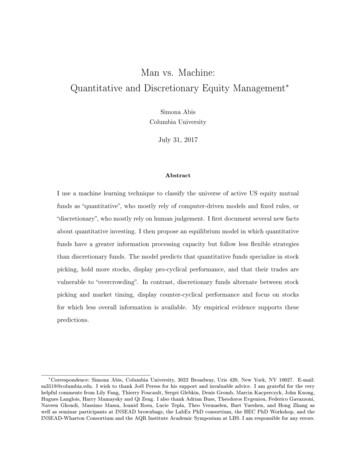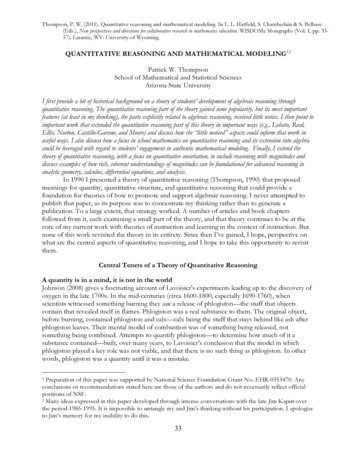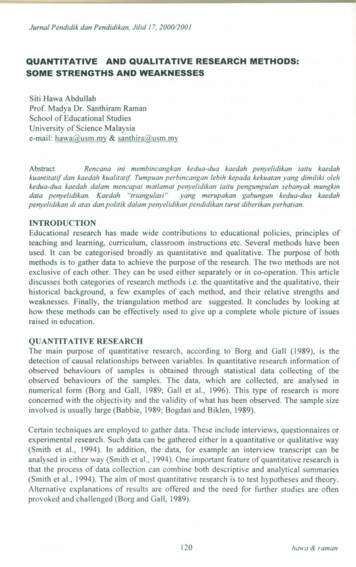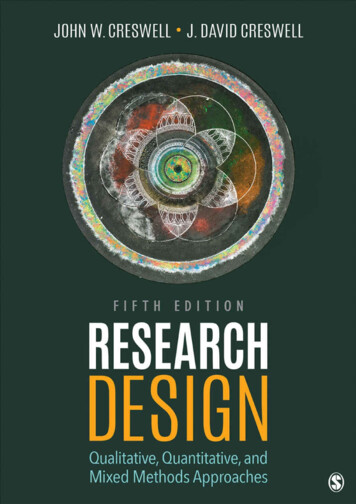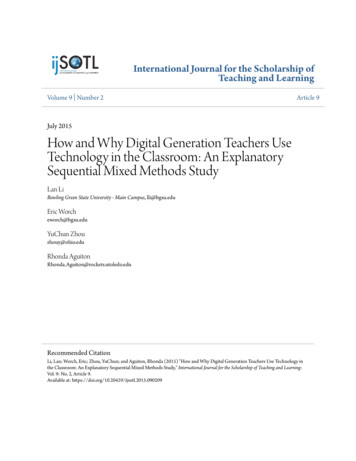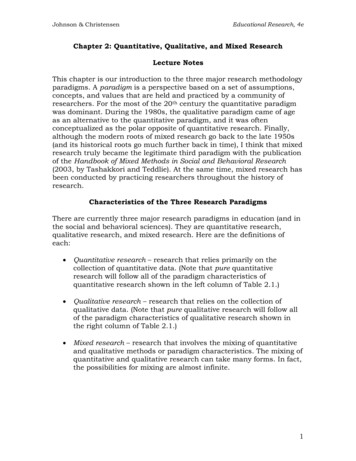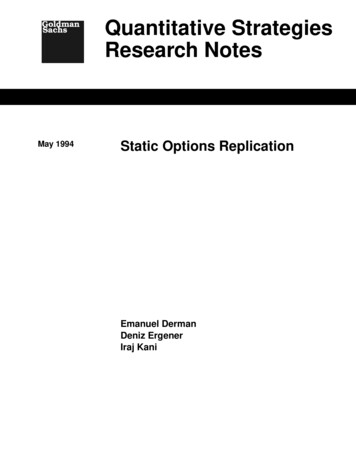
Transcription
GoldmanSachsMay 1994Quantitative StrategiesResearch NotesStatic Options ReplicationINTERNAL DISTRIBUTIONEmanuel DermanDeniz ErgenerIraj Kani
GoldmanSachsQUANTITATIVE STRATEGIES RESEARCH NOTESCopyright 1994 Goldman, Sachs & Co. All rights reserved.This material is for your private information, and we are not soliciting any action based upon it. This report is not tobe construed as an offer to sell or the solicitation of an offer to buy any security in any jurisdiction where such an offeror solicitation would be illegal. Certain transactions, including those involving futures, options and high yieldsecurities, give rise to substantial risk and are not suitable for all investors. Opinions expressed are our presentopinions only. The material is based upon information that we consider reliable, but we do not represent that it isaccurate or complete, and it should not be relied upon as such. We, our affiliates, or persons involved in thepreparation or issuance of this material, may from time to time have long or short positions and buy or sell securities,futures or options identical with or related to those mentioned herein.This material has been issued by Goldman, Sachs & Co. and/or one of its affiliates and has been approved byGoldman Sachs International, regulated by The Securities and Futures Authority, in connection with its distributionin the United Kingdom and by Goldman Sachs Canada in connection with its distribution in Canada. This material isdistributed in Hong Kong by Goldman Sachs (Asia) L.L.C., and in Japan by Goldman Sachs (Japan) Ltd. Thismaterial is not for distribution to private customers, as defined by the rules of The Securities and Futures Authorityin the United Kingdom, and any investments including any convertible bonds or derivatives mentioned in thismaterial will not be made available by us to any such private customer. Neither Goldman, Sachs & Co. nor itsrepresentative in Seoul, Korea is licensed to engage in securities business in the Republic of Korea. Goldman SachsInternational or its affiliates may have acted upon or used this research prior to or immediately following itspublication. Foreign currency denominated securities are subject to fluctuations in exchange rates that could have anadverse effect on the value or price of or income derived from the investment. Further information on any of thesecurities mentioned in this material may be obtained upon request and for this purpose persons in Italy shouldcontact Goldman Sachs S.I.M. S.p.A. in Milan, or at its London branch office at 133 Fleet Street, and persons in HongKong should contact Goldman Sachs Asia L.L.C. at 3 Garden Road. Unless governing law permits otherwise, youmust contact a Goldman Sachs entity in your home jurisdiction if you want to use our services in effecting atransaction in the securities mentioned in this material.Note: Options are not suitable for all investors. Please ensure that you have read and understood thecurrent options disclosure document before entering into any options transactions.
GoldmanSachsQUANTITATIVE STRATEGIES RESEARCH NOTESEmanuel DermanDeniz ErgenerIraj Kani(212) 902-0129(212) 902-4673(212) 902-3561We thank Yoshikazu Kobashi and Daisuke Toki for their interest andencouragement, and Alex Bergier and Barbara Dunn for their comments.-2
QUANTITATIVE STRATEGIES RESEARCH NOTESSUMMARYThis paper presents a method for replicating or hedging a targetstock option with a portfolio of other options. It shows how to construct a replicating portfolio of standard options with varying strikesand maturities and fixed portfolio weights. Once constructed, thisportfolio will replicate the value of the target option for a wide rangeof stock prices and times before expiration, without requiring furtherweight adjustments. We call this method static replication. It makesno assumptions beyond those of standard options theory.You can use the technique to construct static hedges for exoticoptions, thereby minimizing dynamic hedging risk and costs. You canuse it to structure exotic payoffs from standard options. Finally, youcan use it as an aid in valuing exotic options, since it lets you approximately decompose the exotic option into a portfolio of standardoptions whose market prices and bid-ask spreads may be betterknown.Replicating an Exotic Option with a Portfolio of Standard Options.Option Value5e toextim10095thsths512 months3 mon6mon9mon909095ths10010x level0s510ths001112 months3 mon6 month9 monpindexpto e12time115120x levelReplicating Portfolio Value11inde11GoldmanSachsthsThe figure above, taken from an example in this paper, illustrateshow the technique works. The graph on the left shows the value of aone-year up-and-out call, struck at 100 with out-barrier at 120, for alltimes to expiration and for market levels between 90 and 120. Thegraph on the right shows the value of a replicating portfolio constructed from seven standard options, struck either at 100 or 120,and expiring every two months over the one-year period. You can seethat the replicating portfolio value approximately matches the targetoption value over a large range of times and stock prices, and has thesame general behavior. The more standard options you include in thereplicating portfolio, the better the match.-1
GoldmanSachsQUANTITATIVE STRATEGIES RESEARCH NOTESTable of ContentsIntroduction . 1First Steps Towards Replication4The Method of Static Replication in a Binomial World10Options Valuation by Backward Induction10The Principle of Static Replication . 12An Explicit Example: Static Replication of an Up-and-Out Call12Static Replication Strategy in the Real World17A Practical Example . 22Replicating an Up-and-Out Call . 22Appendix A: Some Exact Static Hedges27Appendix B: Mathematics of Static Replication340
GoldmanSachsINTRODUCTIONQUANTITATIVE STRATEGIES RESEARCH NOTESAccording to the Black-Scholes theory1, a stock option at any instantbehaves like a weighted portfolio of risky stock and riskless zero-coupon bonds. The Black-Scholes options formula tells you how to calculate the portfolio weights. They depend on the stock price level, thestock dividend yield, the stock volatility, the riskless interest rate andthe time to expiration.Instead of owning an option, you can in principle own a portfolio ofstock and riskless bonds, and achieve exactly the same returns. To doso, you must continuously adjust the weights in your portfolio according to the formula as time passes and/or the stock price moves. Thisportfolio is called the dynamic replicating portfolio. Options tradersordinarily hedge options by shorting the dynamic replicating portfolio against a long position in the option to eliminate all the riskrelated to stock price movement.There are two difficulties with this hedging method. First, continuousweight adjustment is impossible, and so traders adjust at discreteintervals. This causes small errors that compound over the life of theoption, and result in replication whose accuracy increases with thefrequency of hedging. Second, there are transaction costs associatedwith adjusting the portfolio weights which grow with the frequency ofadjustment and can overwhelm the profit margin of the option. Traders have to compromise between the accuracy and cost.In this paper we describe a method of options replication thatbypasses some of these difficulties. Given some particular targetoption, we show how to construct a portfolio of standard options, withvarying strikes and maturities and fixed weights that will not requireany further adjustment and will exactly replicate the value of thetarget option for a chosen range of future times and market levels. Wecall this portfolio the static replicating portfolio.Our method relies only on the standard assumptions behind theBlack-Scholes theory. Therefore, the value and sensitivities of thestatic replicating portfolio are equal to the usual theoretical valueand sensitivities of the target option. You can use this static replicating portfolio to hedge or replicate the target option as time passesand the stock price changes. By increasing the number of options inthe static portfolio, you can achieve better replication. The costs2 of1. F. Black and M. Scholes, The Pricing of Options and Corporate Liabilities, Journalof Political Economy, 81 (May-June 1973), 637-54.2. We will consider costs in a future paper.1
GoldmanSachsQUANTITATIVE STRATEGIES RESEARCH NOTESreplication and transaction are embedded in the market prices of thestandard options employed in replication.In this paper we apply the method only to options with one underlying stock. A similar extension to options with multiple underlyers ispossible, but more involved.The static approach to options replication is useful in diverse areas,some of which we list below:1.TradingYou can use static replication to avoid the practical difficulties andcosts involved in dynamically hedging an options position. You canhedge long-term options with portfolios of short-term options, orexotic options with portfolios of standard options. Static replicationis especially suited to hedging exotic high-gamma options whichrequire frequent and costly dynamic hedging. A single static hedgecan reduce potential risk over long periods of time and large rangesof stock price.The static approach uses options to hedge other options positionsover long periods of time. It is therefore naturally suited to managing books that contain large numbers of options, especially in liquid options markets.2.StructuringYou can create a static replicating portfolio with the same payoff asan exotic option, perhaps at a reduced premium. You can even replicate target options of your own design that are not offered in themarket.3.ValuationStatic replication decomposes a target option into a portfolio ofstandard options. The market value of the portfolio provides apractical estimate for the fair value of a target option. This valuemay reflect the true cost of the option more realistically than theusual theoretical value, especially in the presence of transactioncosts, volatility smiles, and other market conditions that violatethe assumptions behind Black-Scholes.You can use the same method to specify a static hedge for a portfolioof target stock (index) options, as well as for options on interest ratesor currencies, though we will not consider those applications in thispaper.2
GoldmanSachsQUANTITATIVE STRATEGIES RESEARCH NOTESThe static replicating portfolio is not unique. You can use a variety ofstatic portfolios available to find one that achieves other aims as well– minimizing volatility exposure, for example. In some cases, it ispossible to find a portfolio consisting of only a small number ofoptions that provides a static hedge (see Appendix A). In general, aperfect static hedge requires an infinite number of standard options.Even so, a static hedge portfolio with only several options can provideadequate replication over a wide variety of future market conditions.Our approach differs from other attempts to statically hedge options.Some earlier methods have used an optimization strategy to minimize the discrepancy between the target and replicating portfolio values over a range of market conditions. Others have focused on findingstatic hedge portfolios in special cases where a small number ofoptions can exactly replicate an exotic target option3.Our approach differs in principle: we can systematically specify, stepby-step, how to find a perfect portfolio that replicates a path-independent exotic option at all future stock price levels and times. In general this requires an infinite number of options. We can then use thesame method with only a limited number of options to replicate thetarget option precisely at a limited number of stock prices and times.By increasing the number of options in the replicating portfolio wecan increase the accuracy of replication. Often, a fairly small portfolioworks adequately, and limits the transaction costs.This paper proceeds as follows. In the next section we investigate anintuitive approach towards replication. We then show how you cangeneralize this method to develop a comprehensive theory of replication. We then illustrate in detail how the method works in a binomiallattice world where only discrete stock price moves are allowed.Finally, we give some practical examples of static replicating portfolios for barrier options. In Appendix A, we present several statichedge portfolios consisting of only small numbers of options that nevertheless exactly replicate an exotic target option under special circumstances. Appendix B reviews the mathematics of staticreplication.3. Peter Carr, Cornell University, Seminar at Goldman, Sachs & Co., August 1993.3
GoldmanSachsFIRST STEPS TOWARDSREPLICATIONQUANTITATIVE STRATEGIES RESEARCH NOTESBarrier options4 have high gamma when the underlying stock priceis in the neighborhood of the barrier. In that region, dynamic hedgingis both expensive and inaccurate, and static hedging is an attractivealternative. In this section we introduce our approach to static replication by trying to use standard (non-barrier) options to replicate anup-and-out European-style call option, described in Table 1.TABLE 1. An up-and-out call option.Stock price:100Strike:100Barrier:120Rebate:0Time to expiration:1 yearDividend yield:5.0% (annually compounded)Volatility:25% per yearRisk-free rate:10.0% (annually compounded)Up-and-Out Call Value:0.656Ordinary Call Value:11.434There are two different classes of stock price scenarios that determine the option’s payoff:1.The stock price does not hit the barrier before expiration. In thiscase, the up-and-out call has the same value as an ordinary callwith strike equal to 100.2.The stock price hits the barrier before expiration. Then the upand-out call is extinguished and has zero value.These are displayed in Figure 1 below.4.4For information on the theory of barrier options, see The Ins and Outs ofBarrier Options, Emanuel Derman and Iraj Kani, Quantitative StrategiesResearch Notes, June 1993.
GoldmanSachsQUANTITATIVE STRATEGIES RESEARCH NOTESstockpricescenario 2: barrier struck,call expires worthlessBscenario 1:barrier avoidedpayoff max(S’- K, 0)S’S K0expirationtimeFIGURE 1. Stock price scenarios for an up-and-out European calloption with strike K 100 and barrier B 120.From a trader’s point of view, a long position in this up-and-out call isequivalent to owning an ordinary call if the stock never hits the barrier, and owning nothing otherwise. Let’s try to construct a portfolioof ordinary options that behaves like this.First we replicate the up-and-out call for scenarios in which the stockprice never reaches the barrier of 120 before expiration. In this case,the up-and-out call has the same payoff as an ordinary one-yearEuropean-style call with strike equal to 100. We name this call Portfolio 1, as shown in Table 2. It replicates the target up-and-out callfor all scenarios which never hit the barrier prior to expiration.TABLE 2. Portfolio 1. Its payoff matches that of an up-and-out call ifthe barrier is never crossed before expiration.Quantity1TypecallStrike100Expiration1 yearValue 1 year before expirationStock at 100Stock at 12011.43425.610The value of Portfolio 1 at a stock level of 120 is 25.610, much toolarge when compared with the zero value of the up-and-out call onthe barrier. Consequently, its value at a stock level of 100 is 11.434,also much greater than the value (0.657) of the up-and-out call.5
GoldmanSachsQUANTITATIVE STRATEGIES RESEARCH NOTESPortfolio 1 replicates the target option for scenarios of type 1. By adding a suitable short position in just one extra option to Portfolio 1, wecan attain the correct zero value for the replicating portfolio at onedefinite future time on the barrier at a stock price of 120. Let’s chooseto do this one year from expiration by cancelling the previous portfolio value of 25.610 at a stock price of 120 with one year to expiration.Table 3 shows Portfolio 2, consisting of a single one-year 100 strikestandard call (that is, Portfolio 1) plus a short position in 1.866 oneyear calls struck at 120. The 120 strike call has no payoff at expiration below the barrier, and therefore doesn’t alter the replication forscenarios of type 1 already achieved by Portfolio 1. Any strike greaterthan 120 would achieve the same goal.Here’s the reason we choose to go short 1.866 120 calls. The theoretical value of the 100 call at a stock price of 120 with one year to expiration in Table 2 is 25.610. The theoretical value of the 120 call is13.721. By going short 25.610 13.721 1.866call options struck at120, we can cancel the theoretical value of the 100 call on the 120barrier with one year to expiration, and so ensure that Portfolio 2 willhave zero value on the 120 barrier.Portfolio 2 replicates the value of the up-and-out call (1) at expirationbelow the barrier, and (2) exactly on the 120 barrier at one year priorto expiration. Table 3 shows that its value when the stock is at 100 is2.832, which is larger than the up-and-out call value of 0.657 at thesame market level. This excess value reflects the fact that the valueof Portfolio 2 is zero on the barrier only at one year before expiration,whereas the up-and-out call’s value is zero on the barrier at all times.Figure 2 shows the value of Portfolio 2 on the 120 barrier at all timesprior to expiration. You can see that its value deviates more dramatically from the zero value of an up-and-out call on the barrier as expiration approaches.Portfolio 2. Its payoff matches that of an up-and-out call ifthe barrier is never crossed, or if it is crossed exactly 1 year beforeexpiration.TABLE 3.QuantityStrikeExpirationValue 1 year before expirationStock at 100Stock at 1201.000call1001 year11.43425.610-1.866call1201 year-8.602-25.6102.8320.000Net6Type
QUANTITATIVE STRATEGIES RESEARCH NOTES2015ValueGoldmanSachs10501 Year9 months6 months3 monthsexpTime to expirationFIGURE 2. Value of Portfolio 2 on the barrier at 120.Portfolio 3 in Table 4 illustrates an alternative replicating portfolio.It adds to Portfolio 1 a short position in one extra option so as toattain the correct zero value for the replicating portfolio at a stockprice of 120 with 6 months to expiration, as well as for all stock pricesbelow the barrier at expiration. Figure 3 shows the value of Portfolio3 for stock prices of 120, at all times prior to expiration. You can seethat the replication on the barrier is good only at six months. At allother times, it again fails to match the up-and-out call’s zero payoff.TABLE 4. Portfolio 3. Its payoff matches that of an up-and-out call ifthe barrier is never crossed, or if it is crossed exactly at 6 months toexpiration.QuantityTypeStrikeExpirationValue 6 months before expirationStock at 100Stock at 1201.000call1001 year7.91522.767-2.387call1201 year-4.446-22.7673.4690.000Net7
GoldmanSachsQUANTITATIVE STRATEGIES RESEARCH NOTES20Value151050-5-101 Year9 months6 months3 monthsexpTime to expirationFIGURE 3. Value of Portfolio 3 on the barrier at 120.By adding one more call to Portfolio 3, we can construct a portfolio tomatch the zero payoff of the up-and-out call at a stock price of 120 atboth six months and one year. This portfolio, Portfolio 4, is shown inTable 5.TABLE 5. Portfolio 4. Its payoff matches that of an up-and-out call ifbarrier is never crossed, or if it is crossed exactly at 6 months or 1year to expiration.QuantityTypeStrikeExpirationValue for stock price 1206 months1 year1.000call1001 year22.76725.610-2.387call1201 year-22.767-32.7530.752call1206 months0.0007.1420.0000.000NetThe value of Portfolio 4 on the barrier at 120 for all times prior toexpiration is shown in Figure 4. You can see that this portfolio does amuch better job of matching the zero value of an up-and-out call onthe barrier. For times between zero and six months the boundaryvalue at a stock price of 120 remains fairly close to zero.8
QUANTITATIVE STRATEGIES RESEARCH NOTES20Value1510501 Year9 months6 months3 monthsexpTime to expirationFIGURE 4. Value of Portfolio 4 on the barrier at 120.By adding more options to the replicating portfolio, we can match thevalue of the target option at more points on the barrier. Figure 5shows the value of a portfolio of seven standard options at a stocklevel of 120 that matches the zero value of the target up-and-out callon the barrier every two months. You can see that the match betweenthe target option and the replicating portfolio on the barrier is muchimproved. In the next section we show that improving the match onthe boundary improves the match between the target option and theportfolio for all times and stock prices.2015ValueGoldmanSachs10501 Year9 months6 months3 monthsexpTime to expirationFIGURE 5. Value on the barrier at 120 of a portfolio of standardoptions that is constrained to have zero value every two months.9
GoldmanSachsTHE METHOD OFSTATIC REPLICATIONIN A BINOMIAL WORLDQUANTITATIVE STRATEGIES RESEARCH NOTESWe will now show how you can statically replicate a target optionwith a portfolio of other options for all times and all market levels.Our method relies on the theory of options valuation.Because its results are easy to visualize, we will employ the binomialmethod of options valuation to illustrate our replication strategy. Inthe binomial method, time passes in quantized steps. At each stepthe stock price is allowed to move up or down a fixed amount. In thelimit where the time steps and the stock moves become smaller andsmaller, the imaginary world of the binomial method approaches amodel in which stock prices change continuously and are distributedlognormally, and its options pricing formula becomes equivalent tothe Black-Scholes solution1.The binomial method is not a different model from the Black-Scholesmodel. It is an alternative way of solving the same options model thatat the same time provides a clear visual picture. We now proceed inthis framework5.Imagine you have a binomial tree of stock prices with a finite numberof time periods between today and expiration. We will show how toreplicate an arbitrary target option with a portfolio of other optionsso that, at every time and stock price allowed in the binomial model,the replication is exact.Options Valuation byBackward InductionIn the binomial method, we value derivative securities with uncertain future payoffs by backward induction in a risk-neutral world.The method is illustrated in Figure 6 for options on stock.There are three components to the method:1.The risk-neutral binomial tree. This is a tree of stock prices constructed so that the mean stock price grows with time like the forward stock price. This constraint follows from the assumption thatoptions can be hedged with stock.5. The method of static hedging we present here can and should be carried out usingthe implied tree when volatility is skewed. See Emanuel Derman and Iraj Kani,Riding On A Smile, RISK, vol 7, no 2, pp 32-39, and The Volatility Smile and ItsImplied Tree, Goldman Sachs Quantitative Strategies Research Notes, January1994.10
GoldmanSachsQUANTITATIVE STRATEGIES RESEARCH NOTES2.The boundary conditions. These are the values of the option onsome boundary in the future where its value is determined (forexample, by the option’s terms) at each stock price node on theboundary. The values of the option everywhere inside the boundary are uniquely determined by these boundary values.3.The backward equation. This is the formula for computing all earlier option values from the boundary option values by movingbackwards down the tree. In mathematical form, the equation represents the statement that a hedged position must earn the sameinstantaneous return as a riskless money-market account. In thelimit of infinitesimally small time steps and stock moves, the backward equation becomes the Black-Scholes equation.stockpricerisk-neutralbinomial treeof stock pricescurrentoptionvalueboundary wherefuture optionvalues are knownbackwardequationtimeFIGURE 6. The method of backward induction.The risk-neutral binomial tree depends only on interest rates, thecurrent stock price, the stock volatility and the stock dividend yield.The backward equation is the same for all securities whose valuesare contingent on the stock price. Only the boundary condition differsfrom security to security. If two different portfolios have the samevalues everywhere on the boundary, and produce the same cashflowsinside this boundary, the backward equation dictates that they willhave the same values everywhere inside the boundary. This leads tothe principle of static replication.11
GoldmanSachsQUANTITATIVE STRATEGIES RESEARCH NOTESThe Principle of StaticReplicationYou can replicate a target security for all future stock prices andtimes within some boundary by constructing a portfolio of securitieswith the same net cashflows within this boundary and the same netvalues on the boundary.An Explicit Example:Static Replication of anUp-and-Out CallLet’s illustrate how this works. In order to concentrate on the essenceof the method, we’ll make certain simplifying assumptions. Droppingthese assumptions does not invalidate our method; it just makes theexplanation less transparent. So, we assume that interest rates andstock dividend yields are zero, and that the stock is worth 100 today.We also assume that the stock price can move up or down 10 withequal probability (of 1/2) only at the end of each year. Figure 7 showsthe binomial tree of stock prices for this stock in the risk-neutralworld over the next five years.0Time(years)21345150Stock Treeeach node shows: stock 706050FIGURE 7. A binomial tree of stock prices in dollars. Up and downmoves have equal probability.12
GoldmanSachsQUANTITATIVE STRATEGIES RESEARCH NOTESLet’s choose a five-year up-and-out European-style call with a strikeof 70 and a knockout barrier of 120 as the target barrier option we’lltry to replicate. This option has a natural boundary at expiration infive years, where it expires, and on the knockout barrier at 120.These boundaries are shown in Figure 8.Time(years)021345knockout boundaryUp-and-Out Call Treeeach node shows: call expiration boundary0FIGURE 8. A binomial tree of call prices for a five-year European-styleup-and-out call with strike at 70 and barrier at 120. The corresponding stock prices at each node are shown in Figure 7.For those scenarios in which the stock price reaches expiration inyear 5 without having touched the knockout boundary, the call hasthe payoff of an ordinary call. Its boundary value on each node in theheavily shaded expiration boundary in Figure 8 iscall value max ( S – 70, 0 )(EQ 1)At all nodes on the knockout boundary at a stock level of 120, the callis worth zero.13
GoldmanSachsQUANTITATIVE STRATEGIES RESEARCH NOTESAt earlier times the value of the call is given by the formulaCu CdC ----------------2(EQ 2)Equation 2 is the backward equation familiar to users of binomialmodels. Cu,d denotes the call value at the up and down nodes oneyear in the future. ( C u C d ) 2 is the expected value of the call, andsince we have chosen interest rates to be zero for pedagogical simplicity, there is no need to discount the expected value. You can check tosee that the value of the call at each earlier node in the tree, belowthe knockout boundary and before expiration, is obtained by usingthis equation to work backwards in time through the tree. If we constructed stock and option trees with smaller and smaller time periodsbetween successive levels, Equation 2 would become equivalent tothe Black-Scholes equation. The up-and-out call is worth 11.88today in this simplified binomial world with one-year steps.How can you replicate this up-and-out call with ordinary options?You need to create a portfolio of ordinary options that have the samepayoff on the boundaries. The four trees in Figure 9 illustrates theprocedure we use. The boundary on which we want to match thevalue of the up-and-out option is shown as a heavy grey line. Tree 1 isthe tree of binomial stock prices. Tree 2 is the tree for a replicatingportfolio that matches the target option’s payoff on the expirationboundary. Tree 3 is the tree for a portfolio that also matches the payoff at one point on the knockout boundary. Finally, Tree 4 shows theperfect replicating portfolio that matches the target option’s payoff onall boundaries, and therefore at every node inside the boundary aswell.Tree 1 shows the stock prices at each node. Tree 2 shows the value ofan ordinary 5-year call struck at 70. It has the same values as the upand-out call of Figure 8 at expiration in year 5 at all nodes below thebarrier of 120. Therefore, this ordinary call replicates the up-and-outcall perfectly if the barrier is never struck. However, the ordinary callhas a value of 50 at those stock nodes labeled A and B that correspond to stock prices of 120 in year 2 and year 4. In contrast, the upand-out call has zero value at those nodes.14
GoldmanSachsQUANTITATIVE STRATEGIES RESEARCH 01001009090(1)707060long 1110908080130505-year call, strike 0500long1 5-year call, strike 70short 10 5-year calls, strike -220-4040(3)2000long1 5-year call, strike 70short 10 5-year calls, strike 120long5 3-year calls, strike 50(4)20105000FIGURE 9. Replicating an up
Trading You can use static replication to avoid the practical difficulties and costs involved in dynamically hedging an options position. You can hedge long-term options with portfolios of short-term options, or exotic options with portfolios of standard options. Static replication is especially suited to hedging exotic high-gamma options which
